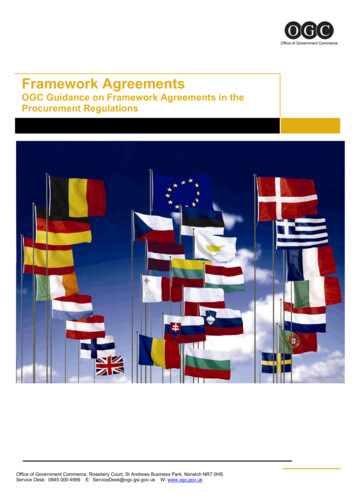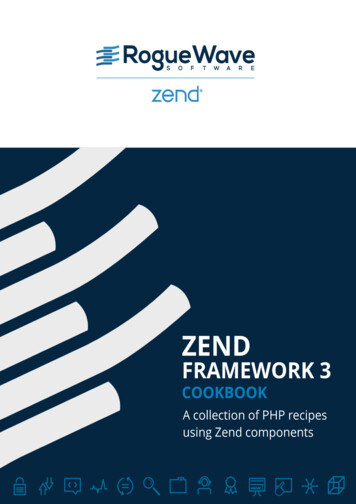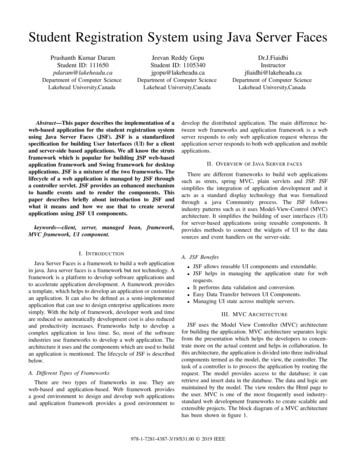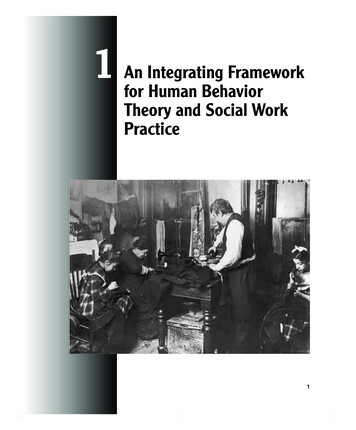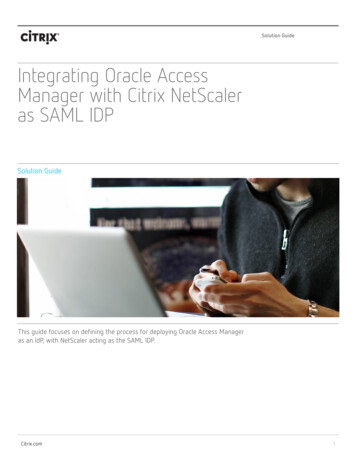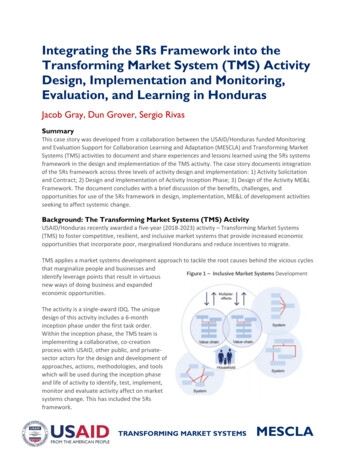
Transcription
Integrating the 5Rs Framework into theTransforming Market System (TMS) ActivityDesign, Implementation and Monitoring,Evaluation, and Learning in HondurasJacob Gray, Dun Grover, Sergio RivasSummaryThis case story was developed from a collaboration between the USAID/Honduras funded Monitoringand Evaluation Support for Collaboration Learning and Adaptation (MESCLA) and Transforming MarketSystems (TMS) activities to document and share experiences and lessons learned using the 5Rs systemsframework in the design and implementation of the TMS activity. The case story documents integrationof the 5Rs framework across three levels of activity design and implementation: 1) Activity Solicitationand Contract; 2) Design and Implementation of Activity Inception Phase; 3) Design of the Activity ME&LFramework. The document concludes with a brief discussion of the benefits, challenges, andopportunities for use of the 5Rs framework in design, implementation, ME&L of development activitiesseeking to affect systemic change.Background: The Transforming Market Systems (TMS) ActivityUSAID/Honduras recently awarded a five-year (2018-2023) activity – Transforming Market Systems(TMS) to foster competitive, resilient, and inclusive market systems that provide increased economicopportunities that incorporate poor, marginalized Hondurans and reduce incentives to migrate.TMS applies a market systems development approach to tackle the root causes behind the vicious cyclesthat marginalize people and businesses andFigure 1 – Inclusive Market Systems Developmentidentify leverage points that result in virtuousnew ways of doing business and expandedeconomic opportunities.The activity is a single-award IDQ. The uniquedesign of this activity includes a 6-monthinception phase under the first task order.Within the inception phase, the TMS team isimplementing a collaborative, co-creationprocess with USAID, other public, and privatesector actors for the design and development ofapproaches, actions, methodologies, and toolswhich will be used during the inception phaseand life of activity to identify, test, implement,monitor and evaluate activity affect on marketsystems change. This has included the 5Rsframework.TRANSFORMING MARKET SYSTEMSMESCLA
5Rs Framework in the TMS ActivityThe 5Rs framework has contributed to the design and implementation of the TMS activity on multiplelevels. This case story will look at three levels which are building the foundation for integration of the5Rs framework through activity implementation: TMS solicitation and contractTMS inception phase design and implementationTMS ME&L framework1) TMS Solicitation & ContractReference to the 5Rs system framework within the USAID/TMS activity solicitation established anexplicit expectation around the use of the 5R framework in processes for understanding and analyzingthe Honduran market system. Within the solicitation, two references to the 5Rs framework wereparticularly important for establishing an expectation for use in the activity design and implementationprocesses:Defining key concepts and approaches. The TMS solicitation presents a definition of market systemsdefined by the USAID funded LEO Activity which clearly outlines the roles of the 5Rs in a market system:A dynamic space – incorporating resources, roles, relationships, rules and results – in whichprivate and public actors collaborate, coordinate and compete for the production, distributionand consumption of goods and services.”Guidance for analysis, priority setting and work planning. The solicitation promotes the use of 5Rs toinform activity design. This includes guidance for how the activity will carry out analysis:In collaboration with USAID/Honduras, the Activity will invest in early and ongoing analysis tomap the key elements of the market system, potential intervention points, and identify signs ofchange resulting from USAID’s investment seek(ing) to define the inter-connection in thesystem using a framework of relationships, roles, rules, resources and results.”2) 5Rs and TMS Inception Phase Design and ImplementationThe 5R’s framework has been featuredin the design, communication andtraining of TMS staff, stakeholders andUSAID personnel. The 5R’s has beenintegrated in:Establishing a shared understanding ofmarket systems development. TheTMS team has incorporated the 5Rsframework into core communicationmaterials. The 5Rs serve as a tool forcommunicating 1) what is a systemsbased approach and how it differs frommore traditional approaches 2) theFigure 1 – Slide from Presentation to USAID/Honduras CORs, KeyStakeholders and Staff Demonstrating the Incorporation of the5Rs Framework in the TMS Development HypothesisTRANSFORMING MARKET SYSTEMSMESCLA
different system elements of the activity will engage in 3) the link between a systems approach and thetheory of changeTraining of staff and contracted serviceproviders in systems approaches. TMSled a two-day Market systemsDevelopment training for TMS andUSAID/Honduras staff. The trainingprovided a shared understanding of, andcomfort working with systems concepts,approaches, methods, and tools –including the 5rs framework. Thisintroduction was also provided tocontracted service providers that aredoing formative analyses. The TMS teamadapted the 5Rs to the context of themarket system to explain and establish ashared understanding of the coreelements of a market system and marketsystem analysis.Figure 2 – TMS Training Slide Demonstrating the Incorporationof the 5Rs Framework in the TMS Market Systems ApproachDevelopment of the TMS Theory ofChange (TOC) - linking system changes to5Rs and identifying leverage points. Thehas used the 5Rs to develop, revise and review the TMS theory of change and system map included inthe proposal and forming the core framework for the activity design. Facilitated through the third day ofthe market systems training, this introduced to staff how to work with system’s diagrams, identifydesired changes in the system to improve competitiveness, resilience, and inclusion, and identifypotential leverage points which the activity could act upon to influence those changes.Figure 3 – TMS System Change WorksheetTRANSFORMING MARKET SYSTEMSMESCLA
Figure 4 – TMS Team Analyzing Different Parts of the Market SystemFor each system change, participants assessed the 5Rs, identifying changes in one or more Rs whichwould be important to realizing system change. For each R, participants then reviewed differentleverage points, identifying those which would be important for the TMS activity to work with.5Rs and formative analyses. TMS has also designed its formative analysis to integrate the 5R’sframework:Figure 5: TMS Learning Framework for Formative AnalysisAnalysis ComponentsQuestions and Research Areas Who/what are the actors, their role insector and their potential in facilitation ofdesired changes in TMS TOC Predominance of business models,Learning question: Who playsbarriers to upward mobility and other keywhat function in the sector andgaps in system – e.g. too little or toowhat are opportunities for themany of a specific stock of roleadoption of more value-added History and trajectory or roles, changes infunctions?the market and potential to adapt orexpand in responses to changes.2. the nature of relationships Effectiveness of alliances, cooperationbetween these actors,and competition between firms within theincluding their levels ofsector, noting barriers to entry.cooperation and Strength of relationships: cooperative tocompetitionadversarial, effective to ineffective,(RELATIONSHIPS)strong to weak, formal to informal, valueadded to extractive.Learning question: Whatrelationships can TMS enhanceto encourage more effectivecooperation and competitionwithin the sector?1.the firms and actors thatoperate within the sector(ROLES)Integrated Analyses Will-skill matrix as part of subjectmatter expert meetings to facilitatedesired changes in TMS TOC Value chain or sectoral mapping toidentify the firms and actors, andrelationships in the sector Gender & social inclusion analysisto evaluate roles of marginalizedgroups and potential to take onmore value-added roles. Social network analysis to identifystrength of relationships betweenenterprises and support services Gender & social analysis toidentify differences and barriers toalliances, competition andcooperation of marginalizedgroups.TRANSFORMING MARKET SYSTEMSMESCLA
Flows within and into/out of the system. Social network analysis to evaluateResources include information, services,access to and use of differentfinance, donor/public funding, retainedresources by enterprisesearnings, labor and services. Entrepreneurship system mapping Availability of these resources andto understand resource availabilitycritical resource gaps to facilitate morefor start-up and growth enterprisescompetitive, inclusive and resilient Included business services andLearning question: Howgrowth of sectors and systemsfinancial services as two of theeffective are providers andtarget economic sectors to analyzechannels for investment of Gender & social inclusion toresources (information, finance,evaluate differential access toetc.) into the system?resources by marginalized actors4. formal and informal rules, Formal and informal rules including laws, Commercial, legal and institutionalwhich drive the behaviors policies, procedures, implementing andreform analysis to evaluate theof these actors (RULES)supporting institutions that impact thelegal framework, implementingsector.and support institutions aroundLearning question: What arereform Informal values, biases, and beliefs thatthe rules that govern / influenceshape how firms behave. Gender & social inclusion analysishow the system operatesto evaluate formal and informal Identify firm engagement in the policy(policies, incentives, formalrules that marginalize peopleprocess - monitoring, development,informal rules, social norms and advising the formulation andvalues)?implementation. Growth opportunities, requirements, End market analysis to lusivenesscompetitive advantages in targetInclusiveness, Resiliencepotential, stressors, adaptive capacitiesmarket segments and positioning(RESULTS)to take advantage of opportunities The root causes of why the sector fails togenerate more competitive, inclusive or Gender & social inclusion toresilient resultsevaluate potential for inclusionwithin the economic sector Hypothesized leverage points at whichTMS Activity could intervene to enablesystemic change3.financial and nonfinancial resourcesavailable, includingtechnical, business andfinancial services(RESOURCES)3) 5Rs and the TMS ME&L FrameworkThe TMS activity is developing their ME&L system to monitor and evaluate the TMS activity. Thisincludes a tiered analytical framework to link Activity Goals, to Systems Changes, to Leverage Points toIntervention Plans. The activity will be using systems diagrams in lieu of more traditional, linear logicmodels to articulate the activity ToC and how the TMS activity will catalyze systemic change.Figure 6 – One possible ME&L System TMS is Exploring to Measure Systems & Systemic ChangeTRANSFORMING MARKET SYSTEMSMESCLA
Systems diagrams maps are developed and validated using the 5R’s framework and related analyticaltools. It also includes the use of a mix of performance and other indicators to be able to effectively trackperformance at various stages of change, evaluate validity of change pathways and test for unintendedconsequences. TMS is considering developing a systems health index, which may relate to the 5Rs.Figure 7 – Using the 5Rs Framework for Analyzing and Diagramming the System:When does System Change Become Systemic? An important element of the TMS activity will bemonitoring and measuring to what extent changes in the system (i.e., changes in the 5Rs) are influencingsystem shifts which result in systemic change: Change in one or more component (5Rs) of a systemwhich fundamentally changes how a system produces (processes) outputs of the system (results) in asustained way. The TMS and MESCLA team is currently experimenting with a couple differentframeworks including the Transform, Scale, institutionalize1 framework, and the Satisfaction,Continuation, Innovation, Investment, Replication2 framework which they will ultimately use to helpthem monitor and measure the extent to which the 5Rs are influencing systemic change.Benefits of Working with the 5RsTMS and MESCLA have noted some of the benefits of working with the 5Rs during the early phases ofTMS activity inception including: The Rs in themselves are recognizable and readily communicable to new audiences. In this way,they are helpful to facilitating comprehension and an entry into getting people to thinksystemically and appreciate the complexity behind some issuesEstablishes a clear point of difference in approach – it makes it clear that this is not the sameframework or way of thinking - than what people are traditionally used to doing1A New Framework for Systemic Change, Retrieved July 10, 2018, -systemic-change/2Disrupting Systems Dynamics: A Framework for Understanding Systemic Changes. USAID LEO Report No. 47.TRANSFORMING MARKET SYSTEMSMESCLA
The orientation around the result has been insightful in focusing in on the ‘why’ behind activitiesand in helping the TMS team and stakeholders to think more broadly and define largerboundaries and answer “what system are we working with”?Lessons Learned and Opportunities for Working with the 5RsThe TMS and MESCLA team have encountered a few challenges and identified opportunities foradvancing use of the 5Rs framework in TMS, and more broadly, market systems development activities. Definitions are important. Establishing an activity-espoused definition for the target systemwhich is based on the 5Rs has resulted in integration of the 5Rs within the activity design itself,and the processes the TMS team will use to further develop scope, priorities, interventions andME&L of the activity. However, despite the consensus around the definitions of 5Rs, there is lessconsensus on the definitions for relevant concepts – such as systems vs. systemic change,leverage points, etc. Establishing clear definitions for these terms is important to ensure theconcepts are similarly communicated and understood by different stakeholders. Change in 5Rs and measuring systemic change. The relationship between when and how achange in the system – vis a vis – a change in one or more of the Rs becomes or influences a“systemic” change – meaning one that results in significant, sustained in how a system producesresults is still a bit of a black box. Monitoring and measuring how changes in the 5Rs influencesystemic change is an important area to further advance practice through development of toolsand processes and sharing practical experiences and learning. Defining boundaries – systems within systems. Systems are made of systems. In some cases,the result of one system may be a resource for another system. In facilitating discussions aboutthe 5Rs for a system, frequently the “resources” individuals identify – such as “Community Will”are the type of resource which may be both an intermediate result and a resource for a longerterm result: “Retaking Ownership of Public Space”. Defining “resources” can be a bit difficult forparticipants. 5Rs and Leverage Points. One of the big conceptual and design challenges is defining what is aleverage point. The work from Donella H. Meadows on “Thinking in Systems” currently providesthe most comprehensive source for defining leverage points for systemic change. The TMS andMESCLA team is working internally to clarify the relationships between “leverage points” andthe 5Rs. Questions raised in workshops have included: Can a R in a system be a leverage point?Do leverage points result in a change in one of the Rs? Or a change in the system itself? Wouldan activity use an R, such as Relationships to move a leverage point? Or would a leverage pointresult in a shift in the R?This challenge originates around lack of clear definition and understanding of leverage in asystem. Bringing clarity to leverage points is an important opportunity which could significantlyhelp those working in systems change better understand the relationship between leveragepoints, 5Rs, and systems changeTRANSFORMING MARKET SYSTEMSMESCLA
system analysis. Development of the TMS Theory of Change (TOC) - linking system changes to 5Rs and identifying leverage points. The has used the 5Rs to develop, revise and review the TMS theory of change and system map included in the proposal and forming the core framework for the activity design. Facilitated through the third day of




